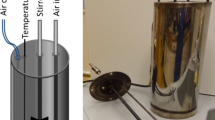Abstract
Chemical functional groups such as carbonyls, sulfoxides and unsaturations are considered the most significant changes that occur in bitumen molecules with oxidation. Such transformations influence the mechanical and thermal responses of the material. This study aims to analyze the topic by means of producing highly oxidized bitumens to correlate oxidation indexes to rheological and thermodynamic parameters. The results showed that the chemical changes largely influence the rheological and thermal responses. It was found that the stronger interactions that bond the oxidized molecules cause the bitumen to exhibit a more glassy-like behavior, which is translated into higher crossover and lower glass transition temperatures. These findings highlight the importance of knowing the chemical composition of bitumen and how it changes through the materials’ service life to determine the temperatures at which the material is more susceptible to fatigue cracking.
Access this chapter
Tax calculation will be finalised at checkout
Purchases are for personal use only
Similar content being viewed by others
References
Herrington, P., Wu, Y.: Effect of inter-molecular association on bitumen oxidation. J. Petrol. Sci. 17, 291–318 (1993). https://doi.org/10.1080/10916469908949719
Petersen, J.: Asphalt oxidation: An overview including a new model for oxidation proposing that physicochemical factors dominate the oxidation kinetics. Fuel Sci. Technol. Int. 11(1), 57–87 (1993). https://doi.org/10.1080/08843759308916058
Soenen, H., Lu, X., Laukkanen, O.: Oxidation of bitumen: Molecular characterization and influence on rheological properties. Rheological Acta 55, 315–326 (2016). https://doi.org/10.1007/s00397-016-0919-6
Villegas-Villegas, R.E., Baldi-Sevilla, A., Aguiar-Moya, J.P., Loria-Salazar, L.: Analysis of asphalt oxidation by means of accelerated testing and environmental conditions. Transp. Res. Rec. 1–12, (2018). https://doi.org/10.1177/0361198118777630
Mouazen, M., Poulesquen, A., Vergnes, B.: Correlation between thermal and rheological studies to characterize the behavior of bitumen. Rheological Acta 50(2), 169–178 (2011). https://doi.org/10.1007/s00397-011-0534-5
Benbouzid, M., Hafsi, S.: Thermal and kinetic analyses of pure and oxidized bitumens. Fuel 87(8–9), 1585–1590 1585–1590. (2008). https://doi.org/10.1016/j.fuel.2007.08.016
Petersen, J.C., Harnsberger, P.M., Robertson, R.E.: Factors affecting the kinetics and mechanisms of asphalt oxidation and the relative effects of oxidation products on age hardening. Div. Fuel Chem. American Chem. Soc. 41(4), 1232–1244 (1996)
Petersen, J.C., Glaser, R.: Asphalt oxidation mechanisms and the role of oxidation products on age hardening revisited. Road Mater. Pavement Des. 12(4), 795–819 (2011). https://doi.org/10.1080/14680629.2011.9713895
Apostolidis, P., Xueyan, L., Kasbergen, C., Scarpas, A.: Transportation research record. J. Transp. Res. Board 2633, 147–153 (2017). https://doi.org/10.3141/2633-17
Garcia Cucalon, L., Kaseer, F., Arámbula-Mercado, E., Epps Martin, A., Morian, N., Pournoman, S., Hajj, E.: The crossover temperature: Significance and application towards engineering balanced recycled binder blends. Road Mater. Pave. Des. 1–22, (2018). https://doi.org/10.1080/14680629.2018.1447504
Author information
Authors and Affiliations
Corresponding author
Editor information
Editors and Affiliations
Rights and permissions
Copyright information
© 2022 The Author(s), under exclusive license to Springer Nature Switzerland AG
About this paper
Cite this paper
Baldi, A., Villegas-Villegas, R.E., Aguiar-Moya, J.P., Loria-Salazar, L.G. (2022). The Chemistry Behind Rheological and Thermal Transitions of Oxidized Bitumen. In: Di Benedetto, H., Baaj, H., Chailleux, E., Tebaldi, G., Sauzéat, C., Mangiafico, S. (eds) Proceedings of the RILEM International Symposium on Bituminous Materials. ISBM 2020. RILEM Bookseries, vol 27. Springer, Cham. https://doi.org/10.1007/978-3-030-46455-4_224
Download citation
DOI: https://doi.org/10.1007/978-3-030-46455-4_224
Published:
Publisher Name: Springer, Cham
Print ISBN: 978-3-030-46454-7
Online ISBN: 978-3-030-46455-4
eBook Packages: EngineeringEngineering (R0)




